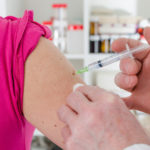 Give Shingles a One-Two Punch
Give Shingles a One-Two Punch
Do you recall having chickenpox as a child? Itchy, fluid-filled, red blisters covering your entire body? High fever? A pretty miserable condition.
Well, thank goodness those childhood illnesses are a thing of the past…or are they? Lurking in the bodies of people who’ve had exposure to this blistering virus as a child is chickenpox’s nasty sequel, shingles. Shingles loves to pop its ugly head (and blisters) up in the second half of our lives, becoming increasingly more prevalent with each decade after 50.
Chickenpox and shingles are both caused by the varicella virus. As a child, chickpox, while being quite uncomfortable, doesn’t carry with it any serious complications. Shingles, on the other hand, does. The symptoms of shingles begin as a tingling, burning, pinching sensation areas on the skin, usually on the face/neck or upper torso. Soon, fluid-filled blisters erupt in a band-like path along the dermatome of an underlying nerve, causing SEVERE pain. In 10-13% of shingles sufferers, the severe nerve pain (postherpetic neuralgia), can last for months or even YEARS after the blisters have resolved! On rare occasion brain inflammation, vision loss, and facial paralysis can even occur.
In 2006, the first shingles fighting vaccination, Zostavax®, was introduced. The Center for Disease Control (CDC) encouraged adults 60 and older to get this vaccination. It’s about 51% effective against shingles outbreaks. Unfortunately, while it did offer the only defense available at the time, its effectiveness declined so quickly that it was considered to be completely ineffective within 8 years. (This is why adults weren’t recommended to be vaccinated at an earlier age.)
The latest vaccine targeting shingles, Shingrix®, was just approved by the FDA in November 2017. It’s touted to be 90% effective in the prevention of shingles. Its lasting effectiveness within the body is FAR superior to that of Zostavax®, so much so that the CDC is now recommending all healthy, non-immunocompromised adults to get this vaccination and its booster—given 2-6 months later—beginning at the age of 50. (This is the “one-two punch” I referred to in today’s title.)
Presently, the cost of both doses of Shingrix® is $280. Medicare part D covers this cost, as may your health insurance company. Check with your benefits provider and speak to your doctor to discuss your eligibility to receive this vaccination.